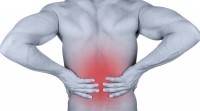Muscular weakness is the true cause of back pain.
Muscular weakness is the number one factor that is overlooked in the diagnosis of lasting back pain. Overuse for one with a strong back, may result in a short term spasm or pain, however after treatment or a few days rest, the back will settle and return to a pain free state.
For people with lasting, chronic back pain, regardless of whether they overuse or rest their back pain persists.
The common blame lies on the diagnosis of wear and tear to the spine, herniated disc/s, inflammation, however these are merely symptoms that were brought about due to a lack of support and postural symmetry.
The body is designed to move, and move in a functional manner. “Use it or lose it” is the best catch phrase to describe why people get muscular weaknesses that result in chronic back pain.
Most of us live a very sedentary lifestyle due to technological advances designed to make our lives easier. Long days at work seated at a desk, only to retire to the couch of an evening to wind down in front of the television, is the surest and fastest way to weaken postural muscles integral to the support of your back.
Both back pain and postural weakness does not just discriminate to office workers, with tens of thousands of tradespeople and manual handlers seeking treatment for their chronic back pain each week in Australia alone. The repetitive nature of most manual jobs, promotes over dominate muscles, which over time creates weakness to the postural muscles due to the over dominate muscles taking over their role/ function.
Muscular weakness is not just the true cause of back pain, it is the reason why people get caught in a chronic back pain cycle for years, often decades. The unfortunate fact being that if these chronic back pain sufferers had addressed their muscular weaknesses soon after experiencing back pain, many years of pain and altered quality of life could have been avoided.
The problem with the standard approach to treating back pain, is that is the majority of techniques incorporated by practitioners only address tight muscles and joints, not the weak muscles. Of the modalities that do address muscular weakness, the exercises are far too passive for the chronic back pain sufferer to restore adequate postural strength. They only focus on ‘core muscles’ completely overlooking the largest muscle groups in the body; the glutes, hamstrings, and adductors that support correct postural symmetry.
In conclusion, no matter if you have suffered from chronic back pain for 2 months, 2 or 20 years if you address your muscular weaknesses you can rid yourself of back pain.

